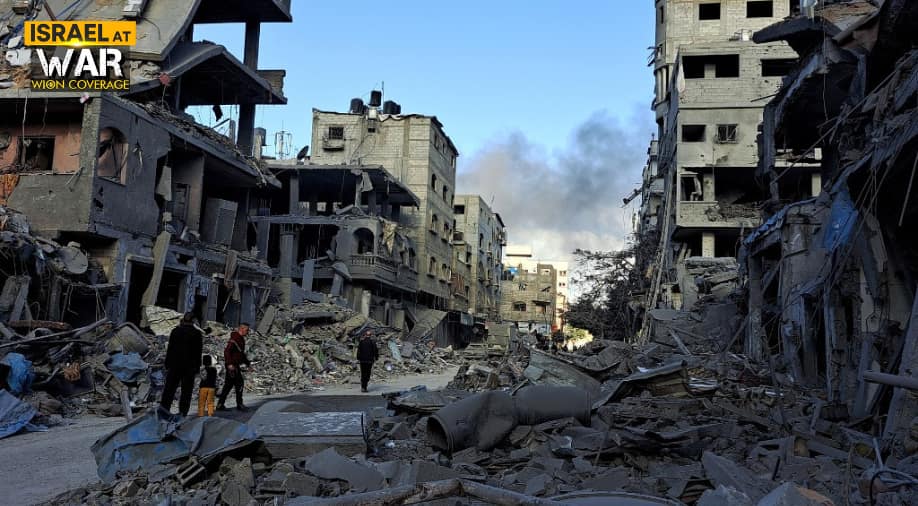Israel-Hamas war: Two fuel tankers a day keep ceasefire calls at bay?
Story highlights
Thomas White, the Director of UNRWA Affairs, stated in a recent post on X that the available fuel is sufficient to operate sewage pumps at a capacity of only 55 per cent
Amid unrelenting strikes, the international community's sluggish response to hostage and aid negotiations, the dire state of Palestinians in Gaza is exacerbated by Israel's operations on the ground. Trapped within a 'circle of death,' Gazans now face the wrath of the rain Gods, rendering their densely populated enclave nearly uninhabitable.
The consequences of this persistent rain are grim, with flooded tents, sewage inundating the streets, and leaky tarp roofs defining the meagre shelters of the Gazans. The overarching question lingers: once this crisis subsides if it does, what will remain of Gaza? The answer remains elusive, overshadowed by the harsh reality Gazans endure.
The besieged enclave is severed from crucial supplies—fuel, aid, water, and food. In this grim reality, bread has become a luxury, while bombs – a grim reality. The blockades and restrictions put in place, have seen a mere 300 trucks enter Gaza—a stark contrast to the pre-war volume and a far cry from what is necessary to meet the enclave's basic needs – whatever is left of it.
trending now
Calls for a ceasefire have yielded little relief, with sporadic aid deliveries providing only temporary respite. These deliveries, sometimes agreed upon only on paper as 'tactical pauses,' serve as a brief reprieve until the inevitable cycle of ceasefire calls and subsequent uproar resumes. Gaza, in its current state, remains a testament to the urgent need for sustained international attention and humanitarian assistance, especially considering the impact of Israel's "mowing the lawn" strategy.
With the United States and Israel unequivocally dismissing the possibility of a ceasefire, the sole concession for the people of Gaza appears to be Israel's allowance of two trucks of fuel entering the besieged enclave daily. This limited supply is critical for maintaining the operational functionality of Gaza's water and sewage systems amid the ongoing air and ground siege imposed by Israeli forces.
The decision to permit 140,000 litres (37,000 gallons) of fuel every two days was made by Israel's war cabinet in response to a "special request" from the United States. This humanitarian gesture underscores the severity of the situation in Gaza and the challenging conditions faced by its inhabitants.
Is the authorisation of these limited fuel supplies merely a temporary measure to appease current unrest, possibly reflecting Israel's aim to maintain its activities in Gaza? This interpretation seems plausible. After all lack of sanitation, clean drinking water, food, and medicines will have far-reaching consequences. Some argue that the outbreak of a larger health crisis in the enclave – say an epidemic in Gaza would not only impact the local population but also pose a threat to Israeli troops, potentially compromising their fighting capability. Additionally, is it a stretch to think that this decision provides diplomatic manoeuvrability for Israel to continue advancing its military operations in a bid to weed out Hamas?
Also read | Indianising internationalisation of higher education: A perspective on International Students' Day
On Wednesday, US Secretary of State Antony Blinken engaged with members of Israel’s war cabinet, cautioning that the fuel shortage presented a serious risk of a humanitarian catastrophe among Gaza’s 2.3 million residents, according to a statement from a State Department official.
US officials have persistently urged Israel to allow the entry of fuel for an extended period. After weeks of non-compliance, it is now perceived that acceding to this request from the US may alleviate international criticism. This is because it is becoming abundantly clear that the international community, including Israel’s staunch allies, are getting jittery over its operations on the ground in Gaza.
But where will the Gazans go when the limited fuel does get the engine running? The answer, for now at least, remains buried in the rubble.
(Disclaimer: The views of the writer do not represent the views of WION or ZMCL. Nor does WION or ZMCL endorse the views of the writer.)
















